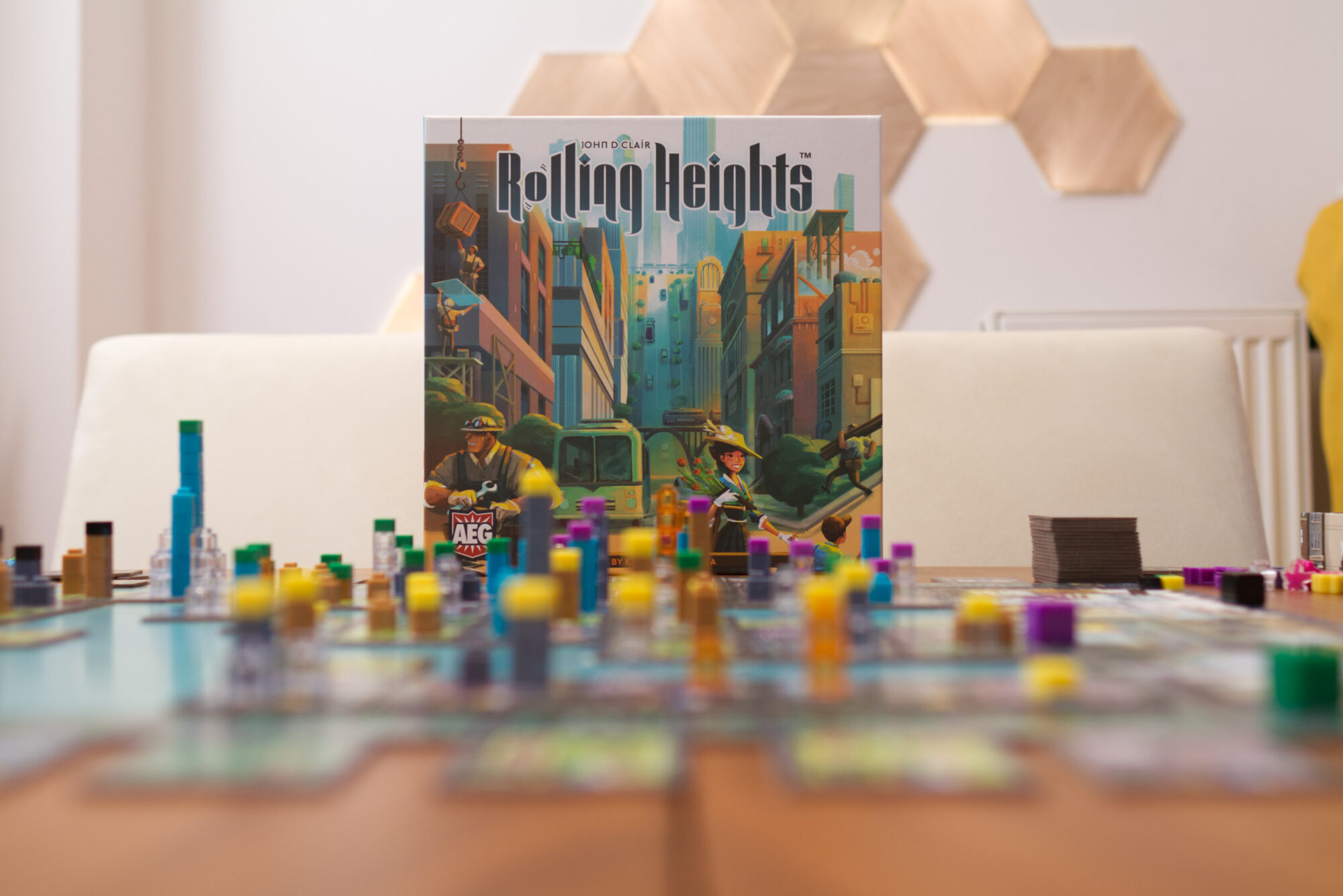Aaah, Kickstarter, what a hodgepodge of emotions! From FOMO to buyer’s remorse, happy anticipation to the dread of something possibly never fulfilling, pride of having backed something amazing to the feeling of superiority when one has managed to miss a dud. Lately, I’ve noticed a new aspect of it which for lack of a better word I’ll call non-buyer’s remorse. Regardless of how much deliberation I’ve put into the decision to not back something, some games hit me on the rebound once they fulfil and the first pictures pop up. Like Foundations of Rome, which based on its campaign I was certain I would hate, then bought on the secondary market out of curiosity and ended up enjoying quite a lot.
Rolling Heights is another case in point where I made the conscious decision not to back it. Sure it looked great, but how much game could there be? And we’re rolling meeples? Is there a reason to have this in a game other than to hide the fact there is not much substance to the rest of the game? Well, a couple of weeks ago I snatched up a copy and dug in to find out. Did curiosity get the better of me or is this a game worth having in my collection? Let’s find out …
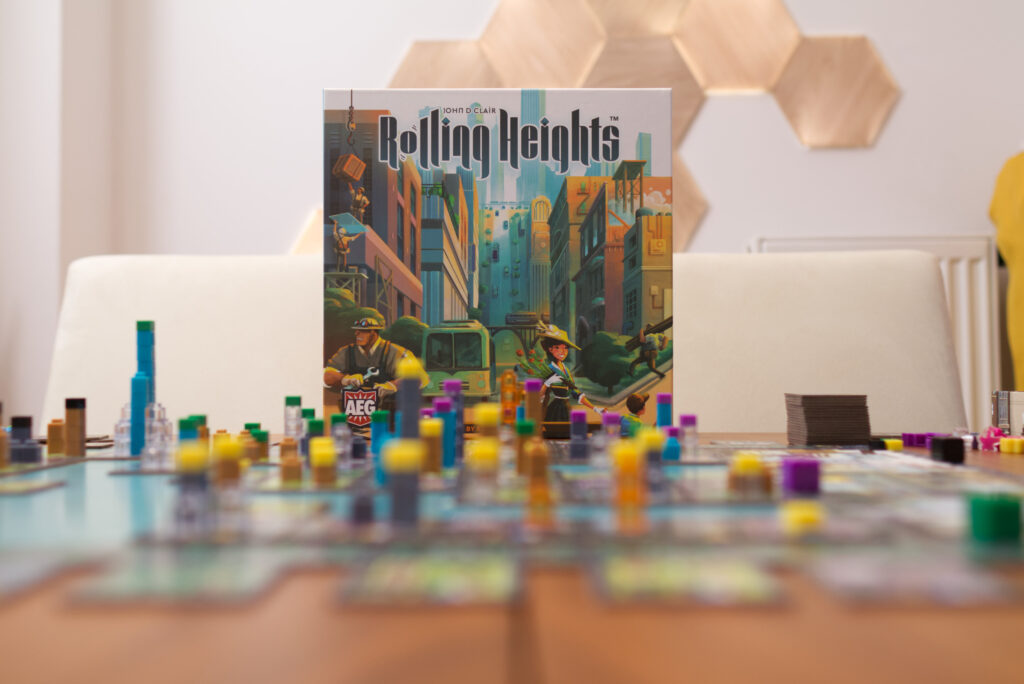
Setup
When opening Rolling Heights’ box, one is greeted by an unusual amount of small plastic bits, both in quantity as well as variety. Most of it consists of small, stackable cubes that immediately reminded me of 1-by-1 Lego blocks but with a very loose fit. These act both as building resources as well as currency of the game. There are a whopping 285 (!) of them in 5 colours and unfortunately, based on player count, a certain number of each type has to be removed from the game during setup. The next major component are the 98 meeples in various colours. No sorting or removal is technically needed here but this game looks so pretty, it would be a shame to dump them all into one pile. Each player starts with two brown carpenters and two dark bluish construction workers, a box to roll them in, and a set of ownership markers used to mark which buildings belong to which player. Each player also gets 2 so called “targets”, unique personal conditions for gaining extra victory points at the end of the game (e.g. gain extra VP for every cube above height 4 in your completed buildings, 1 VP for every opponent’s building adjacent to one of yours).
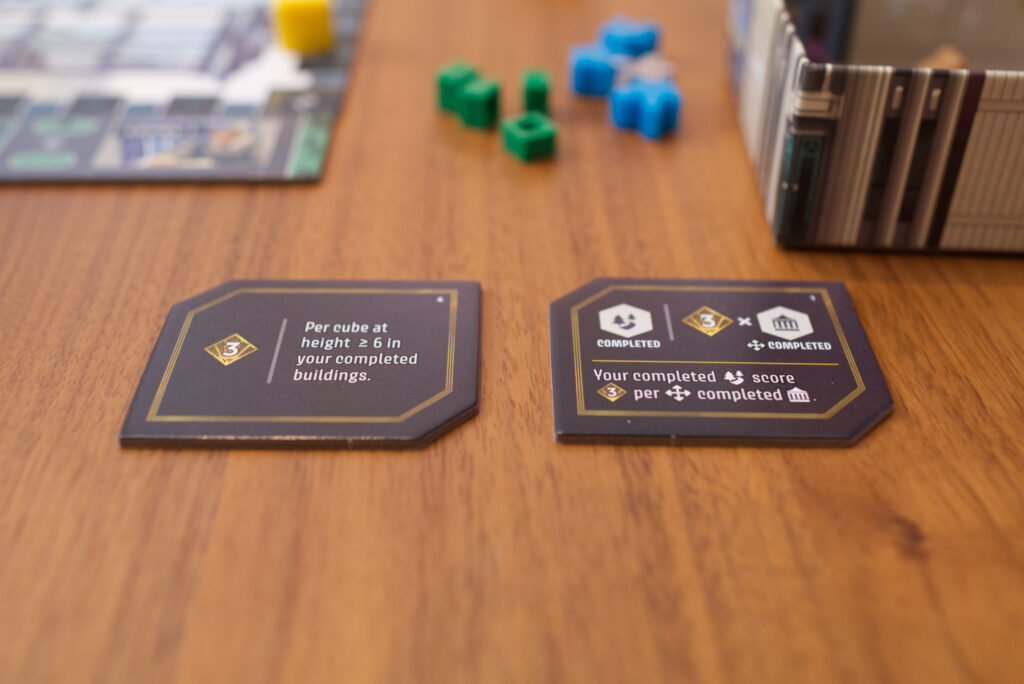
The rest of setup consists of assembling the main playing area by randomising the orientation and placement of the 6 large double-sided neighbourhood boards, preparing two market rows of building plans and drawing 3 so called “ads”, shared building goals or penalties that will affect all players at the end of the game. So overall, setup is rather straight forward and consists mostly of emptying ziplock bags, shuffling building tiles, laying out market rows and preparing stashes of coloured plastic bits.
One thing to highlight here is how well the way the building area is constructed works. The neighbourhood tiles have an A and B side with more and less water spaces respectively. In a 2p game, only A sides are used, and with higher player count, more boards are flipped to their B side that contains less water spaces. So far, that’s not an unusual mechanism. But it’s quite remarkable how much character the distribution of water on each individual neighbourhood contributes to creating a unique feeling city. In one game, a huge internal lake might be created surrounded by large land masses, in another the city is broken into multiple smaller, independent parts, etc. Immediately, Rolling Heights manages to evoke excitement for the game about to commence. The colourful and cartoony art style is also quite lovely.
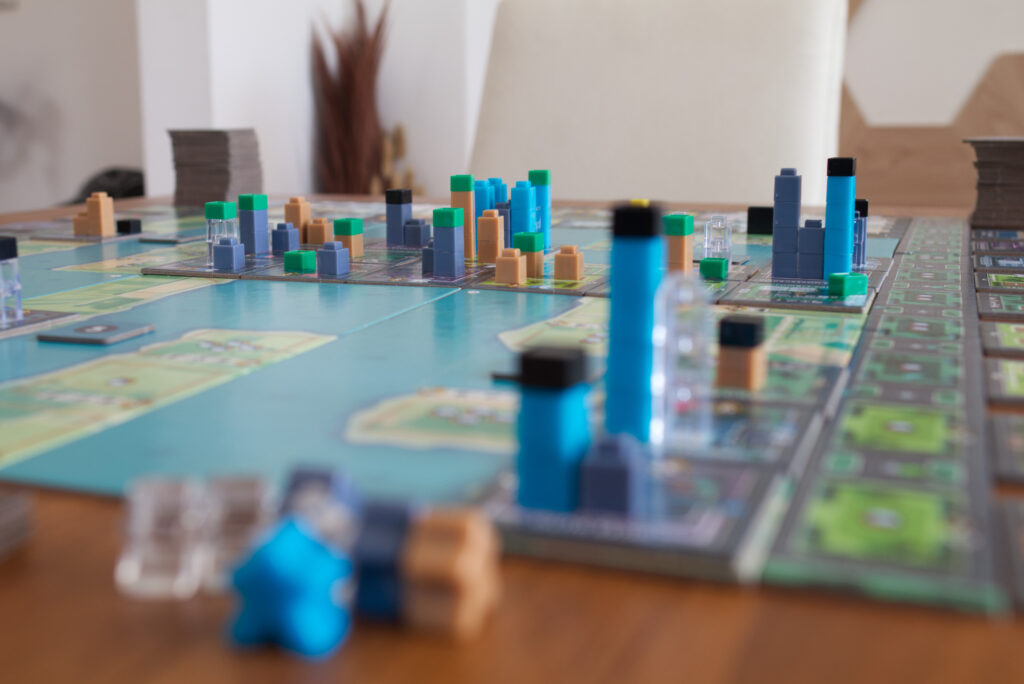
Before starting the game, each player picks a building plan from the level 1 market and places it as their initial starting position on the board. Since a number of ads score based on the location of a player’s completed building (e.g. majority in neighbourhoods. 1VP per row containing at least one building, etc) and the fact that it is costly to build far away from own pre-existing buildings, that initial pick of position can be quite relevant.
The Pre-Turn
Quite unusual, a player’s turn in Rolling Heights kind of starts as soon as they have finished their previous one. While each player begins with a lousy four workers, over the course of the game more and more can be gained by completing buildings. So in preparation of their next turn, a player will select which up to 10 meeples from their workforce they want to use that particular round and throw them into their box. Each meeple lying flat is exhausted (a.k.a. “damn you, why are you ALWAYS landing flat?!?”) and will do nothing this turn, those lying on their side work “steadily” (a.k.a. “at least I get something”) and those standing on their feet work “hard” (a.k.a “FINALLY!”). What that means depends on the type of meeple. For about half of them, working steadily translates to simply getting one resource cube of that colour and working hard to two cubes. But there are also meeples that produce plain victory points, allow changing the state of other meeples, give free re-rolls, or even free building actions.
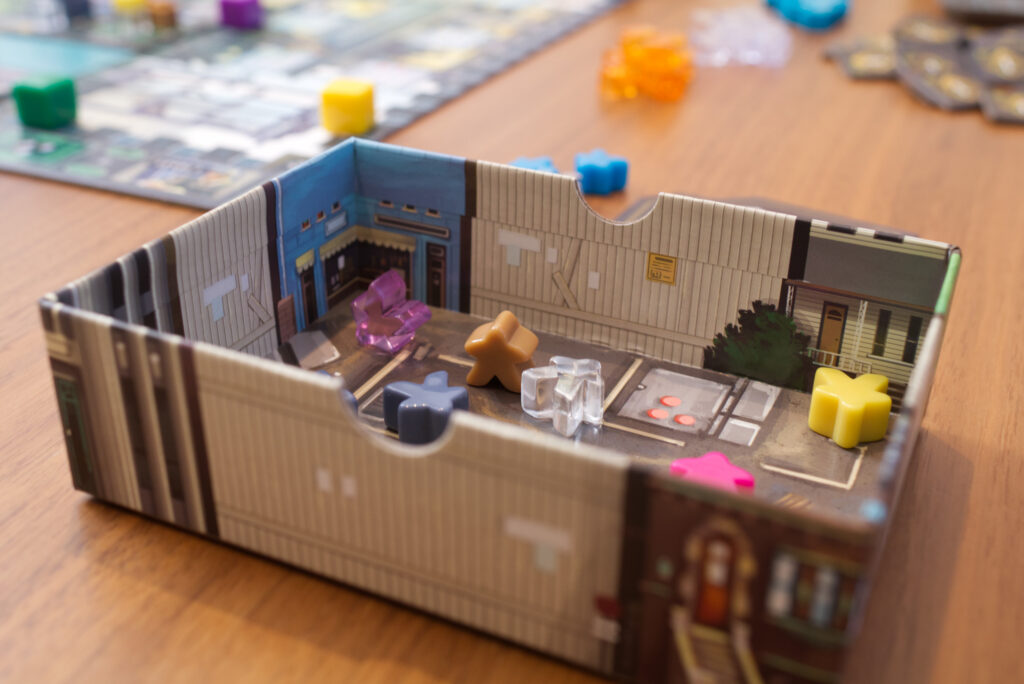
All meeples that are not lying flat are removed from the player’s box and put aside as active workforce. The rest can be rolled again. As long as less than half of a player’s meeples are working, this is risk free. Re-rolling after that causes a strike if all re-rolled meeples again end up being exhausted. But as long as there is no strike, a player can re-roll as often as they want. This is a push-your-luck mechanism where success provides a bigger active work force but failure will actually cut it in half: half (rounded up) of the working meeples already set aside get exhausted and the player will have to work with whatever remains for this turn. As a small consolation price, a player affected by a strike will get a token that acts as a wild resource cube. But it still hurts every time …
This whole act of selecting meeples, rolling and re-rolling can be done during other player’s turns and one is strongly advised to do so to cut down on play time. Ignoring special ability meeples, the rolling of the work force mainly provides players with a selection of cubes they can spent on a given turn. Anything not spent is wasted and goes back to the supply.
The Actual Turn
So what can one do with all those cubes? For one, buy a new building plan from one of the two markets and place it on the board. Both markets work in the familiar fashion of tiles that came in more recently having a higher price and those closer to the front of the line being cheaper. When buying anything beyond the first two tiles, those first two each get a bonus of one of those wild resource tokens mentioned before. Level 1 buildings mostly require wood and concrete – resources all players immediately have access to – and provide a few VP plus access to new workers. Level 2 buildings require more cubes to complete and typically consist of glass and steel, for both of which players first have to acquire the respective meeples by completing level 1 buildings. But they also provide more VP and/or special abilities. So typically players will want to build level 1 buildings to quickly ramp up their workforce to 10 and then switch over mostly to the more lucrative level 2 buildings.
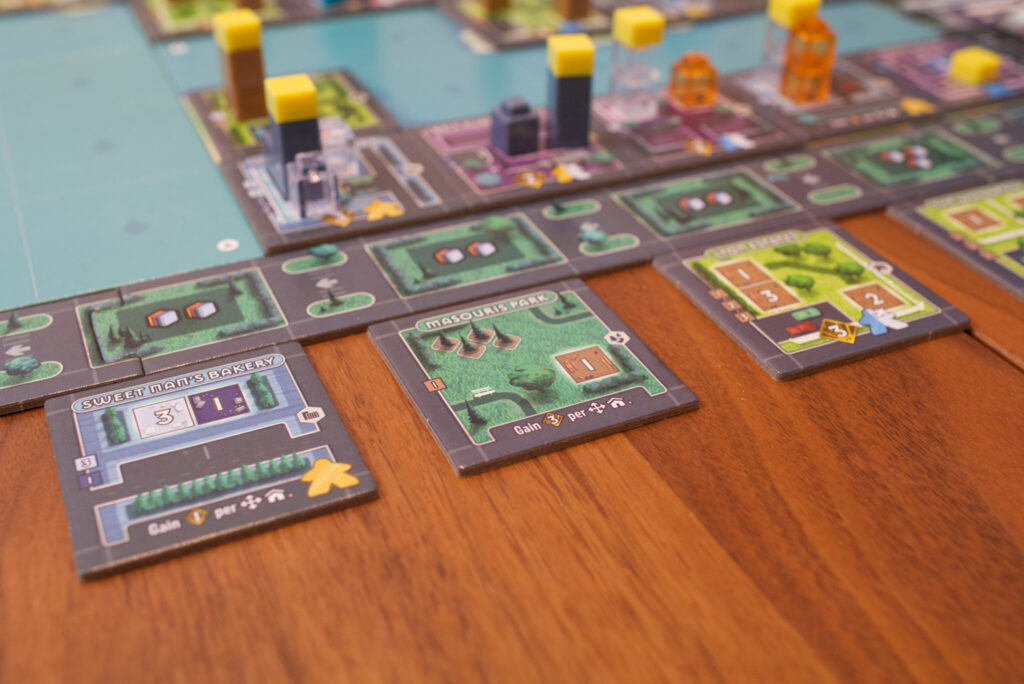
Any building plan bought has to be immediately placed on the board. For any square of distance between the building place and any pre-existing building of that player, an extra cube has to be payed on top of the buying price. This can get pricey towards the end of the game when building space gets less and one might have to cross multiple squares of water to find another available space. Additionally, certain particularly juicy building spots (as printed on the board) cost additional cubes to build upon. However, they also produce immediate VP if the building matches a certain category (e.g. housing).
So let’s take a closer look at the building plans: each contains a number of building spots with a number, indicating what type of resource and how many cubes are required to complete that part of the building. Since those get covered by the cubes, a tiny summary is printed on the left side of each tile. Buildings come in one of five categories as indicated by a small symbol on the right: housing, parks, commerce, industries and public buildings. The type of a building is mostly only relevant for certain scoring criteria of other buildings (e.g. one says 2VP for every adjacent park), end game scoring (both ads and targets), as well as the aforementioned building spot VP printed on the board.
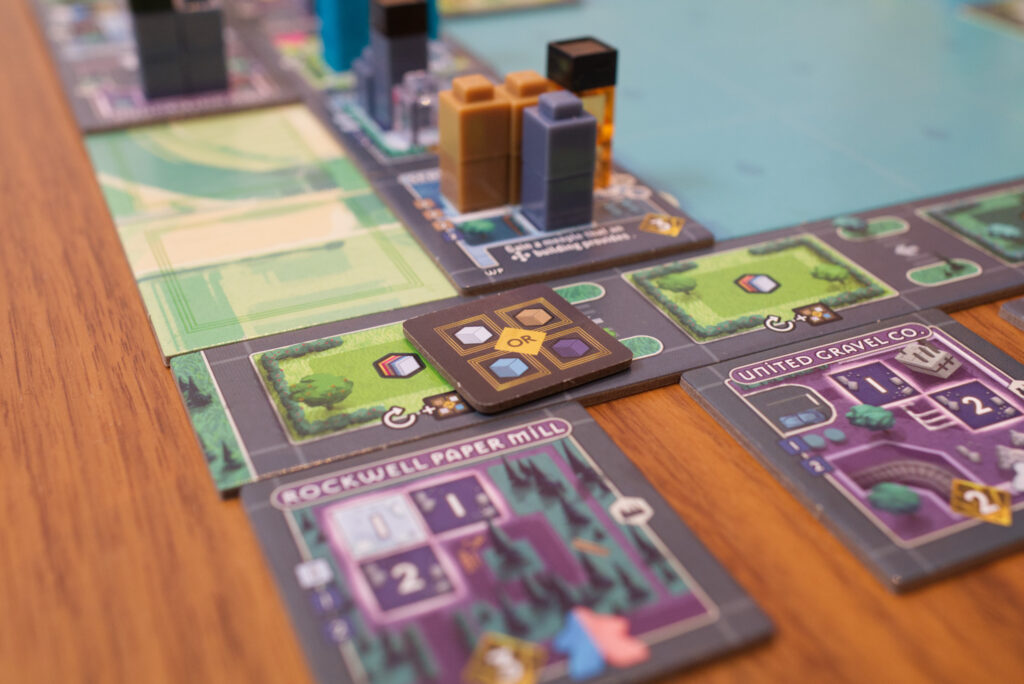
The range in complexity is quite large: from simple houses that can be built with just two wooden cubes to office buildings made of steel and glass that require 20+ cubes. Unlike other city building games like for example Suburbia, most buildings don’t have any special functions. They provide one-time VP as printed at the bottom and an additional 1-2 workers. The big exception are buildings that provide the purple “public figure” meeples. Purple meeples don’t have any inherent function of their own but instead each of those buildings comes with a unique function a player can use for all of their purple meeples from gaining wild-resource tokens to lots of VP.
In order to complete a building, players need to put cubes on to the building plans. This is not a separate action but can be done as much or as little as players want and have the matching resources for. Besides that, there is a trade-in option where players can get rid of unwanted cubes and trade them 2:1 (or 3:1 for steel) into cubes they need. That’s basically it: use the cubes received at the top of the turn, buy and place a maximum of one new building plan, mark it with one of your ownership markers, dump cubes into incomplete buildings and score once completed.
Game End
The game ends once all cubes of one type have been added to buildings. The current round is completed and another final round is played. To work around situations where players need additional cubes of whatever type ran out, there is a set of orange cubes that represent any no longer available type. Once the final round is complete, each player scores the “ads” and chooses one of the two targets they received at the top of the game to score. Whoever earned the most VP wins.
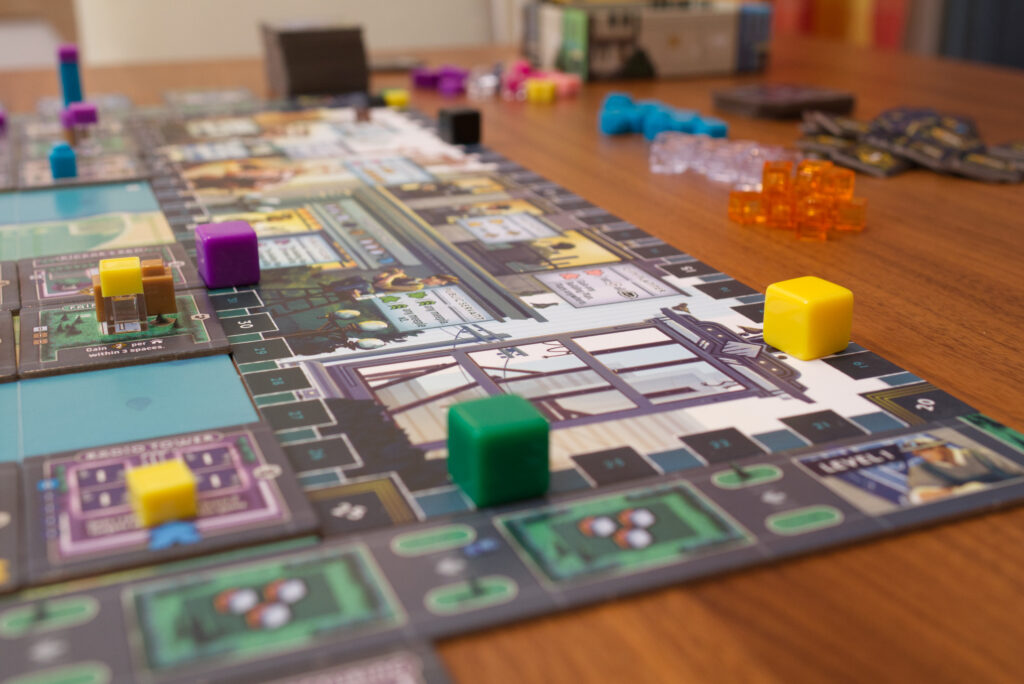
The ads themselves contain the usual suspects: get VP for a majority of completed buildings in a neighbourhood, 1VP per column you own a building in, negative points when building next to factories, collecting sets of building types (e.g. park + housing + factory + commerce) etc. Ads can contribute a quite substantial part of the overall VP, I would guess around 20-30%.
Solo Mode
Rolling Heights comes with a solo mode included, something I always appreciate. This one is rather straight forwarded: each neighbourhood is assigned a number between 1 and 6 and a die roll decides in which neighbourhood the automa builds and which tile in the market it will buy. The automa will try to build as close to the center of the neighbourhood as possible and first start with a level 1 building, then continue with level 2 buildings. If there is already a construction in progress in that neighbourhood, it will instead of buying a new building dump a scary amount of cubes into the existing in-construction building in an attempt to complete it. After a couple of turns, the automa will ramp up by doing two and later three such actions per turn. That’s basically it.
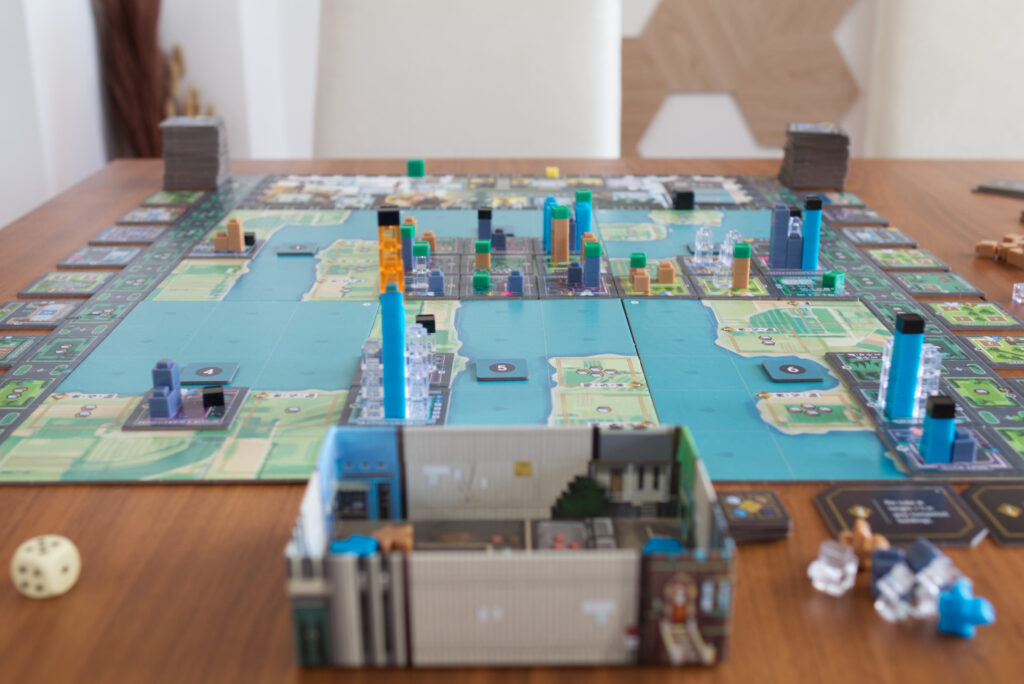
The solo mode works but there is nothing particularly exciting about it. To me it seems like as long as I deny the automa access to large building plans (which it manages to complete blazingly fast) and try to get to 10 workers as quickly as possible, I’m doing okay. But it’s nice to have the option to play a solo round of Rolling Heights if I’m in the mood for something light. I wouldn’t buy this as a solo-only experience though for reasons I’ll discuss in the conclusion.
Funny side note: there was supposed to be a D6 included in the box but it was forgotten during production. The publisher however made the – quite understandable – decision to not ship out thousands of D6s to individual backers but rather assume most people that play solo modes will have one handy anyway.
Kickstarter Expansion Content
For those that backed the Kickstarter, Rolling Heights comes with two mini-expansions. One provides additional tiles that have to be build next to water, the other contains a few extra building tiles and a small gorilla figure. The latter is used for a mini post-game, which is a really fun idea – with a major flaw. The winner of the game holds the gorilla over the board and drops it in an attempt to tear down a large building. Afterwards they place the gorilla on top of another large building and then one of the other players tries to drop a cube on to the gorilla in order to throw it off the building without damaging the building too much. The gorilla wins if after a couple of rounds all large buildings have been torn down and loses if the gorilla was knocked off successfully too many times. Adding a post-game is such a clever idea but in this case not that much of a “game”. The main problem though is that cubes will be flying all over the place and often off the table, creating a little easter egg hunt for all involved where no one can be certain how many pieces are still missing.
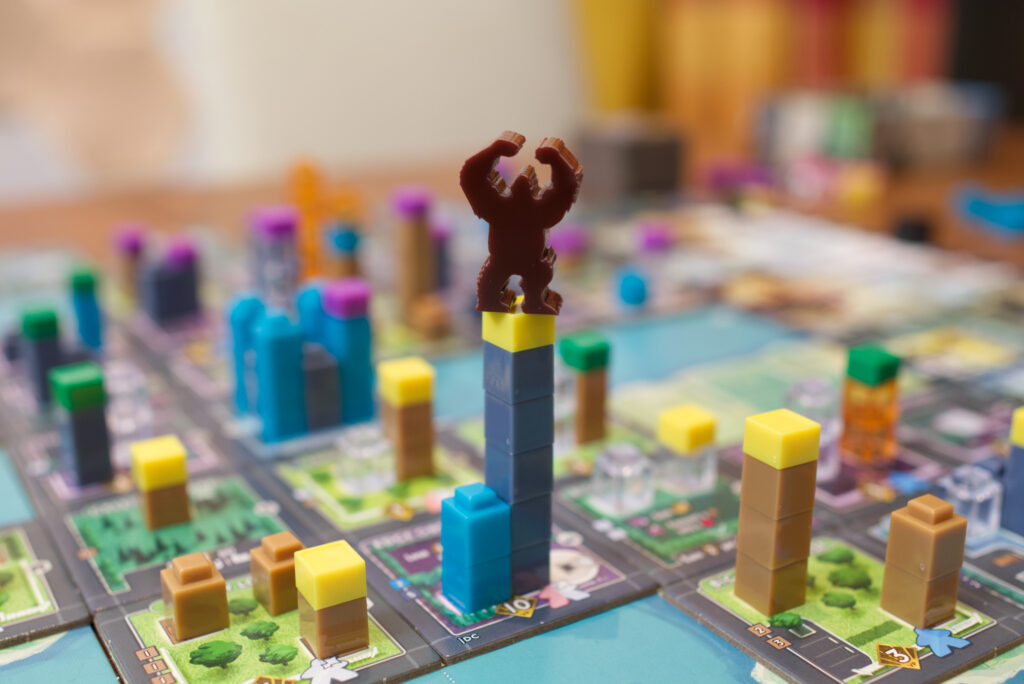
I specifically tried to find a copy of the KS edition to have access to both mini-expansions but I would recommend the reader to simply go with the retail edition. I felt neither of the expansions is worth the extra markup in price and I wouldn’t miss the extra tiles if I wouldn’t have them.
Conclusion
Rolling Heights has a number of things going for it right from the get-go: the way the landscape is constructed feels fresh and inviting, the art style is colourful and cheerful, the completed city at game’s end looks glorious, and the meeple-rolling mechanism is something that gets most people excited to at least give it a try. Based on its looks, hardly anyone will expect a deep tactical building game but quite rightly a fun experience. Rolling Heights easily manages to create great excitement but unfortunately cannot quite deliver on keeping that excitement up until the end.
What most people won’t expect is the game’s play length. Even when using the “roll before it’s your turn” approach, a four player game will usually take two hours plus rules teach … and that only if you keep pushing people to just play instead of over-analysing the board state. Towards the back third when each player has a larger collection of meeples to choose from and more things to consider on the board, AP-prone players can seriously drag down the game flow. Three or two players will of course cut down on the play time, but not as much as one might think.
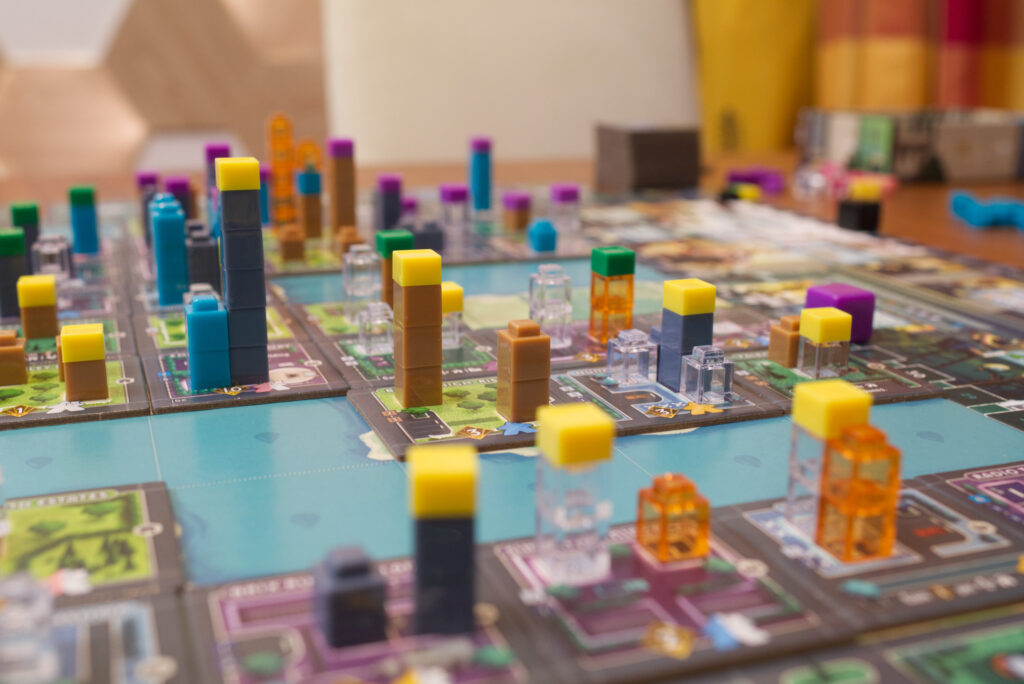
Especially early plays have the tendency to go even longer because new players are not as much racing towards the game’s end as more experienced players. Since the game’s timing mechanism is based on how quickly players drain the supply of cubes, not immediately going for a maximum workforce but instead building whatever fancies one’s curiosity will add substantially to the play time. This reminded me of Maracaibo where the internal timer also depends on how fast players progress. I think it would have been healthy for the game to have some form of pace maker that shows new players what’s what. The recent trend of making automa compatible with non-solo play is really helpful for that aspect and might have been a good approach here. As an alternative, a BGG user has proposed a Construction Boom variant to cut down on the overall play time by starting each player off with an additional meeple and building which I think a lot of players would appreciate, especially during first plays.
There are multiple reasons why the long (or at least longer than expected) playtime is a problem: for one, there isn’t enough depth in the game to justify it. The vast majority of buildings has no special function and when it comes to the different workers, it’s less about picking a strategic path but more what the market offers. If for example no building providing blue steel workers come up, it can be beneficial to zag and go for something completely different. In most cases though, getting steel and glass producing meeples is essential as otherwise most of the level 2 buildings will be out of reach. Not going for the level 2 buildings requires a serious rush effort to end the game quickly (so opponents won’t be able to complete their buildings in time) which is tricky to pull off. Getting politicians (that provide direct VP per roll) is also a viable option, but since they don’t provide any cubes it will seriously slow down one’s own economy and move game’s end further away.
Another reason why Rolling Height’s play length is an issue is that there is relative little player interaction. Sure, there is competition for building space and some of the ads pit players against each other. But in large parts, Rolling Heights can feel like multiplayer solitaire. This especially becomes noticeable in two-player plays as much of the opponent’s turn is spent with re-rolling one’s own meeples. During one of my plays, I was thinking this might be the first game I’ve played that tries to actively distract me from following what my opponent is doing. I was rolling my meeples and when I was done, it was already my turn again. This on paper sounds great but in reality causes detachment from the shared play experience.
There is also little emergent narrative. In Suburbia, my suburb gets character when I place the waste dump next to that housing project and as a result my population goes down. Or my suburb is the only one with a yacht club. Since most buildings in Rolling Heights don’t really have a function, they are quickly forgotten. I couldn’t tell you the name of a single building I constructed during my last play. It’s all just numbers and resource types for me. That’s quite a shame because the city as a whole looks so amazing, I wish there were some stories to tell after a play.
All of these issues would be a non-problem if the game’s arc would be more consistent towards the end and/or the game’s length more in the 60 minutes territory. There is of course also the inevitable problem of accidentally toppling down a building. Luckily, I never had problems re-constructing the board state, so it didn’t really hurt. But it made this a game I won’t take anywhere to play. If you topple a building, chances are some cubes (you can’t be sure how many) fly off the table and who knows where. The one time I played Rolling Heights at another place, we had to count ALL plastic bits after the game to make sure we hadn’t missed picking one up after a couple of buildings were tumbled over and pieces flew all over the floor.
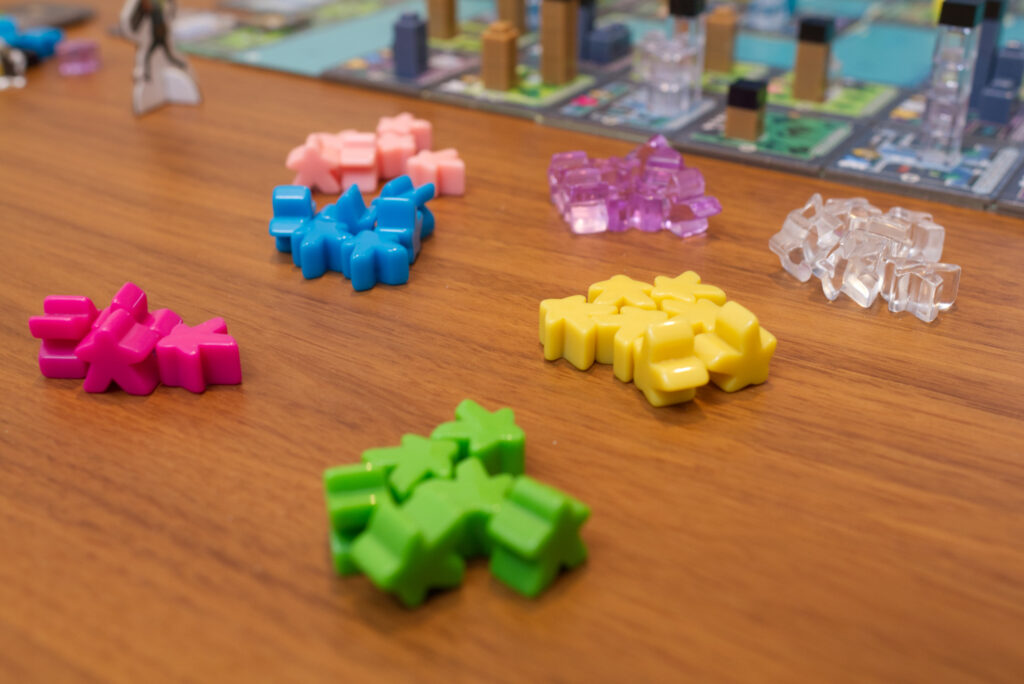
I have other small nitpicks like why the level 1 and 2 buildings don’t have clearly distinguishable backs (sometimes one accidentally ends up shuffled into the draw pile of the wrong market) and how much time is spent shifting the market row. The push-your-luck element also rarely was used in our games because the meeples were way too unpredictable and having a strike in the second half of the game is just too much of a penalty. There is too little reason why one would need to risk potentially having a devastating round instead of just waiting for the next round to go better.
At the end of the day though, hardly any of this really matters. Rolling Heights is a fun, approachable game, and that counts for a lot in my book. What it may lack in depth it more than makes up in charm, especially when playing with new players. Case in point: I’m currently visiting friends and brought a small selection of outstanding games like for example Carnegie. While we had a good time playing it, Carnegie really needs repeated plays to shine. I find myself wishing I would have brought Rolling Heights instead because it’s just plain fun. It might run a bit longer than it should, but anyone can roll meeples, curse when they once again go on strike, and enjoy building those tiny stacks of cubes. Especially in 3 or 4 player plays, the game gives room for table talk and the board state is so easy to parse that one can easily jump in and out of conversations. Two player plays just fine but it feels too much like multiplayer solitaire for my taste.
To sum this up: Rolling Heights has its flaws, but it has gained a place in my collection simply because of the fun factor! It works especially well when playing with changing groups and/or casual players. Rolling meeples and stacking tiny towers of cubes is always a fun premise, even if the game doesn’t end in the exciting climax one hopes for but instead keeps dragging a bit towards the end. Try to stress to new players that Rolling Heights is a race and one has to build up a workforce fast, otherwise you might end up playing way longer than you wanted to. Its biggest handicap for me though is that it lacks both the replayability of a Foundations of Rome and the emergent narrative of a Suburbia. Rolling Heights’ best moments are when it pits players into direct competition for a certain building plan or racing to a particular good building spot instead of just being an efficiency race, which happens way too rarely. I’d really love to see an expansion that uses the solid core mechanisms of the base game but changes it in a way that missing the opportunity to buy that one building plan or losing access to a certain spot on the map is even more decisive.
